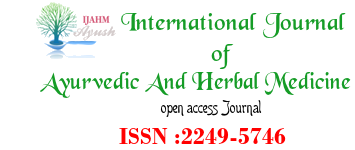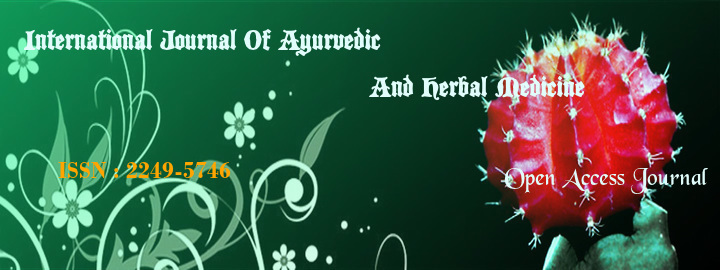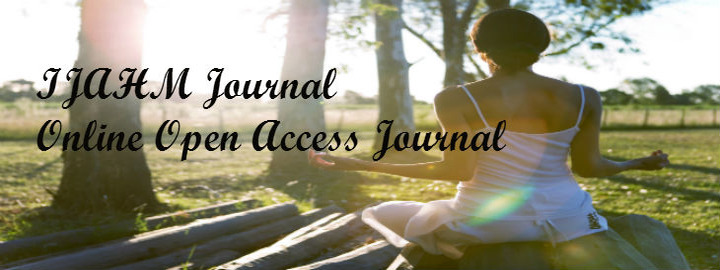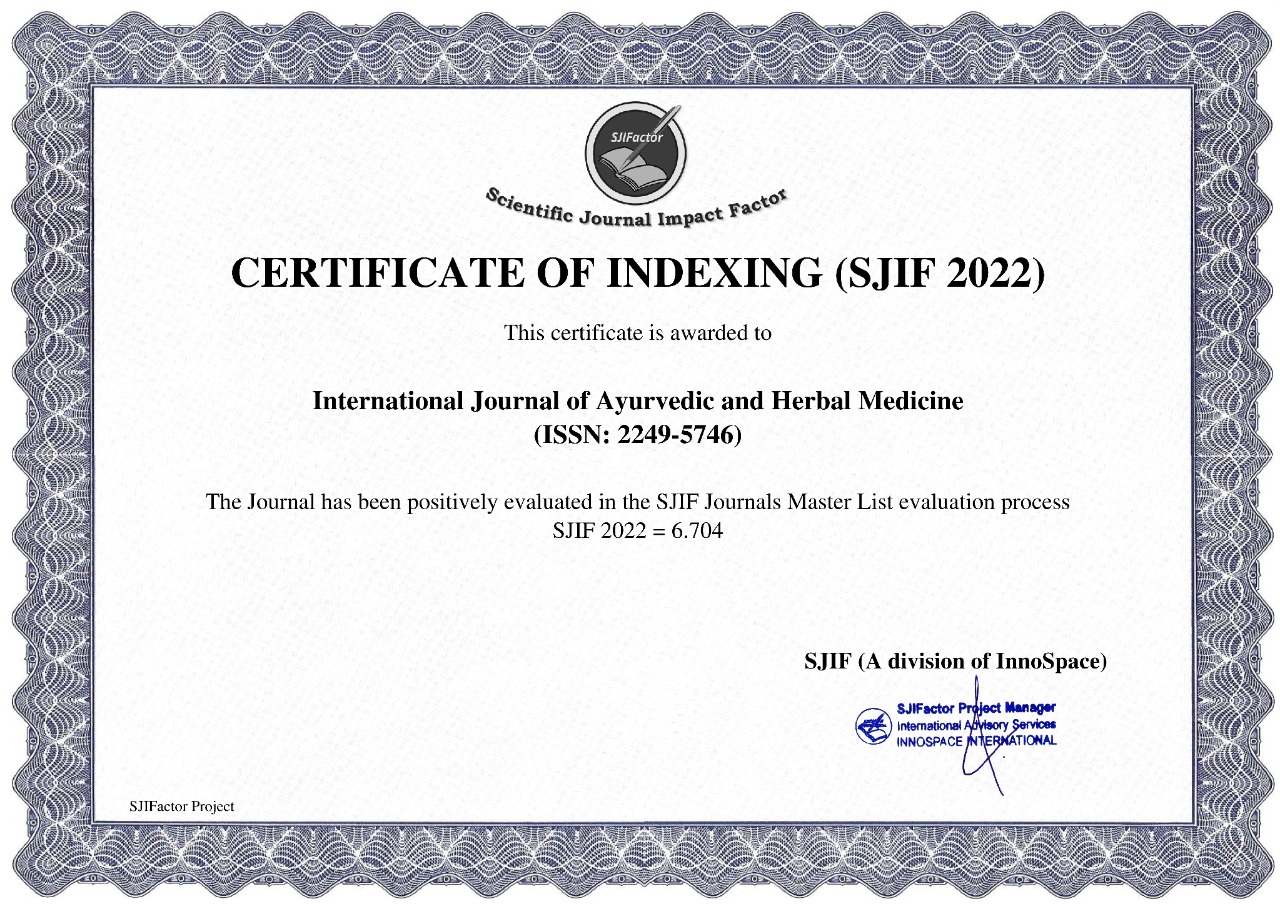


Dr This email address is being protected from spambots. You need JavaScript enabled to view it.
DOI : http://dx.doi.org/10.47191/ijahm/v13i1.03
Abstract:
Skin is the largest organ and covers the entire outer surface of the body. It is largest in terms of surface area and weight. The skin serves three major functions namely; protection, regulation and sensation. During puberty, alteration of the sebaceous lipid profile, called dysseborrhoea, stress, irritation, cosmetics and potential dietary factors lead to inflammation and formation of different types of acne lesions. For many years acne was contributed to dietary patterns but now it has been established that it is a multi-factorial and multi-gene disease.
In Ayurveda, Mukhadushika has been elaborated as one of the Kshudra Rogas (minor ailments) by various Acharyas and the symptoms of Mukhadushika resemble Acne vulgaris as per modern science. Shalmali kantaka like eruptions on the face of adolescents, due to vitiation of Kapha dosha, Vata dosha and Rakta dhatu are known as Mukhadushika or Yuvana pidika or Tarunya pitika. When this pidika gets filled with Meda, it is assigned the term Medogarbha (filled with oil/sebum) pidika.
REFERENCES:
- Aydemir EH. Akne vulgaris etyopatojenez ve patolojisi.Çukurova Tıp Günleri; Adana: 2002. [Google Scholar]
- Gülekon A. Akne etyopatojenezi. II.Vakıf Gureba Tıp Kongresi; İstanbul: 1995. [Google Scholar]
- James WD, Berger T, Elston DM. In: Andrew’s deri hastalıkları.Aydemir EH, translator. İstanbul: Nobel Tıp Kitabevi; 2008. pp. 231–50. [Google Scholar]
- Simpson NB, Cunliff WJ. Disorders of the sebaceous glands. In: Burns T, editor. Textbook of dermatology. 7. Baskı. 3. Oxford: Blackwell Science; 2004. pp. 43–1. [Google Scholar]
- Plewig G, Wolff HH. Braun Falco’s Dermatology.Berlin: Springer; 2000. pp. 1053–82. [Google Scholar]
- Thiboutot DM. Acne. An overview of clinical research findings. Dermatol Clin. 1997;15:97–109. http://dx.doi.org/10.1016/S0733-8635%2805%2970418-6. [PubMed] [Google Scholar]
- Thiboutot DM. Acne and rosacea. New and emerging therapies. Dermatol Clin. 2000;18:63–71. http://dx.doi.org/10.1016/S0733-8635%2805%2970147-9. [PubMed] [Google Scholar]
- Smith EV, Grindlay DJC, Williams HC. What’s new in acne? An analysis of systematic reviews published in 2009–2010. Clin Exp Dermatol. 2011;36:119–23. http://dx.doi.org/10.1111/j.1365-2230.2010.03921.x. [PubMed] [Google Scholar]
- Kurokawa IF, Danby W, Ju Q, et al. New developments in our understanding of acne pathogenesis and treatment. Exp Dermatol. 2009;18:821–32. http://dx.doi.org/10.1111/j.1600-0625.2009.00890.x. [PubMed] [Google Scholar]
- Arora MK, Yadav A, Saini V. Role of hormones in acne vulgaris. Clin Biochem. 2011;44:1035–40. http://dx.doi.org/10.1016/j.clinbiochem.2011.06.984. [PubMed] [Google Scholar]
- Danby FW. Nutrition and acne. Clin Dermatol. 2010;28:598–604. http://dx.doi.org/10.1016/j.clindermatol.2010.03.017. [PubMed] [Google Scholar]
- Davidovici BB, Wolf R. The role of diet in acne: facts and controversies. Clin Dermatol. 2010;28:12–6. http://dx.doi.org/10.1016/j.clindermatol.2009.03.010. [PubMed] [Google Scholar]
- B Dréno, What is new in the pathophysiology of acne, an overview; J Eur Acad Dermatol Venereol. 2017 Sep;31 Suppl 5:8-12. doi: 10.1111/jdv.14374.
- Sykes N, Webster GF. Acne. Drugs. 1994;48:59–70. http://dx.doi.org/10.2165/00003495-199448010-00006. [PubMed] [Google Scholar]
- Ditre CM, Whitney KM. Management strategies for acne vulgaris. Clin Cosmet Investig Dermatol. 2011;4:41–53. http://dx.doi.org/10.2147/CCID.S10817. [PMC free article] [PubMed] [Google Scholar]
- Cunliffe W. Acne vulgaris. In: Lebwohl M, Heymann WR, editors. Treatment of Skin Disease’de Yaz. London: 2002. pp. 6–14. [Google Scholar]
- Cunliff W. Seukeran Acne. In: Katsambas AD, Lotti TM, editors. European handbook of dermatologic treatments. Berlin: Springer; 1999. pp. 3–10. [Google Scholar]
- Polat E, Aygün G, Ergin R, et al. Akne vulgaris patolojisinde demodex folliculorum ve P.acnes’in rolü Türkiye Parazitoloji Dergisi. 2003;27:148–51. [Google Scholar]
- Aydemir EH. Aknede sistemik tedavi yaklaşımları.Ankara: 16. Prof. Dr. ALütfü Tat Simpozyumu; 2003. [Google Scholar]
- Karaduman A. Aknede sistemik antibiyotikler ve bakteriyel direnç.Adana: II. Çukurova Dermatoloji Günleri; 1998. pp. 37–43. [Google Scholar]
- Leyden JL. Current issues in antimicrobial therapy for the treatment of acne. 2001:51–5. http://dx.doi.org/10.1046/j.0926-9959.2001.00013.x. [PubMed] [Google Scholar]
- Show JC. Hormonal therapy in dermatology. Dermatol Clin. 2001;19:169–78. http://dx.doi.org/10.1016/S0733-8635%2805%2970238-2. [PubMed] [Google Scholar]
- Thiboutot DM. Endocrinological evaluation and hormonal therapy for women with difficult acne. 2001:57–61. http://dx.doi.org/10.1046/j.0926-9959.2001.00014.x. [PubMed] [Google Scholar]
- Tunalı Ş, Bülbül E. Aknede antiandrojen tedavi. II.Çukurova Dermatoloji Günleri; Adana: 1998. pp. 61–7. [Google Scholar]
- Giovanna JD. Systemic retinoid therapy. Dermatol Clin. 2001;19:161–7. http://dx.doi.org/10.1016/S0733-8635%2805%2970237-0. [PubMed] [Google Scholar]
- Katsambas A. Oral isotretinoin in acne, only in severe cases? Regional meeting medical education in dermatology. 2001 [Google Scholar]
- Kaviraja Ambikadutta Shastri, Sushruta Samhita,Nidanasthan 13/38, Chaukhamba Sanskrita Sansthan, Varanasi, 2007, pp-287.
- Vagbhata, Ashtanga Hridayam, Uttara Sthana 31/5 with Hindi commentary by Kaviraj Atridev Gupt, Chaukhambha Sanskrit Sansthan, Varanasi, Reprint edition 2003, p-561.
- Kashinatha Shastri,Dr. Gorakhanatha Chaturvedi, Charak Samhitha Sutrasthana, 24/16,ChaukhambhaBharti Academy,Varanasi, 2008, pp445.
- Indradev Tripathi and Dr. Daya Shankar Tripathi, Yogaratnakara, Vaidyaprabha hindi commentary,Kshudra Roga Chikitsa verse 124-125,Chaukhamba Krishnadas Academy Varanasi, 2013, pp-703.
- Sushruta, Sushruta Samhita,Nidana Sthana, 13/3, Ayurveda Tatva Sandipika, Hindi Commentary by Kaviraj Ambika Datta Shastri, Chaukhambha Sanskrit Sansthan,Varanasi, Reprint edition 2021, p-365.
- Sushruta, Sushruta Samhita, Nidana Sthana, 13/38, Ayurveda Tatva Sandipika, Hindi Commentary by Kaviraj Ambika Datta Shastri, Chaukhambha Sanskrit Sansthan, Varanasi, Reprint edition 2021,p-372.
- Bramhashankar Mishra, Bhavaprakasha Vidyotini Tika, Madhyam Khanda 61/31, Chaukhambha Sanskrit Sansthan, Varanasi, 11th edition 2004.
- Sharma H, Bhishgacharya S. Kashyapa Samhita of Vruddhajivaka Chaukhambha Sanskrit Sansthan Varanasi; 2012, p-79.
- Madhava Nidanam of Sri Madhavakara by Dr. Brahmananda Tripathi, Uttarardh 55/33 Chaukhambha Sanskrit Sansthan, Varanasi, Reprint edition 2004, p-276.
- Sharangadhara, Sharangadhara Samhita, Purva Khanda 5/26 annoted withDipika Hindi commentary by Dr.Brahmanand Tripathi, Chaukhambha Surbharati Prakashan, Varanasi, p-57.
- Gupta Sudesh, Sharma Sakshi, Prasher Aarushi, Sharma Kumar Arun, Manhas Raman. MEDICINAL LEECH FOR THE TREATMENT OF ACNE VULGARIS W.S.R. TO MUKHADUSHIKA: A RANDOMISED CLINICAL STUDY. ayush [Internet]. 2021Mar.10 [cited 2021Jun.6];8(1):3064-70.
- Gross, M. Roth The Biochemistry of Leech Saliva
- The wealth of India.VI: L-M. New Delhi: Council of Scientific & Industrial Research (CSIR); 2003. Anonymous; pp. 57–59. [Google Scholar]
- Jordon EL, Verma PS. Invertebrate zoology.New Delhi: S Chand & Company Ltd; 2002. pp. 564–86. [Google Scholar]
- Brown FA. Selected Invertebrate Types.Tokyo: Toppan Company Ltd; 1950. pp. 303–04. [Google Scholar]
- Verma PS. A manual of practical zoology invertebrates.New Delhi: S Chand & Company Ltd; 2006. pp. 288–91. [Google Scholar]
- Sawyer RT. Leech biology and behavior.New York: Oxford University press; 1986. [Google Scholar]
index






















